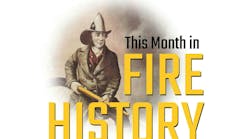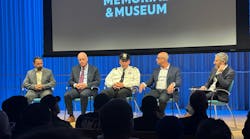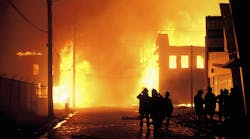The majority of people who work in the fire service do it because they love the job they do. Psychological profiles of those in the fire service, among many other attributes, show an individual who has an overwhelming desire to help another person in distress. Another trait of those who work in the fire service includes the bonding and camaraderie that comes with the job. Combine these two factors and the unsolicited response of thousands of firefighters across the country and the world responding to New York City was predictable.
This is no new phenomenon. After the bombing of the Murrah Federal Building in Oklahoma City in 1995, over 60 different fire departments and ambulance services responded to the site, without the Oklahoma City Fire Department making any mutual aid requests. About 10 years ago, a plane crash at Dallas-Fort Worth International Airport generated spontaneous responses from other public safety agencies and individuals, including an ambulance service from Oklahoma that drove urgent to the scene and even had to stop for gas enroute. Several years ago, during the horrific wildland fires in Florida, after hearing of the countless large fires throughout the state, several members of an Indiana fire department decided to drive urgent to Florida with their brush truck, stopping several times for gas.
The World Trade Center incident was no different and probably brought a never-seen-before response of untold numbers and unsolicited responses from those in the fire service. A fire chief from Georgia told me of a new hire, just out of the academy, who declared on the day of the WTC incident that he was going to New York to help. The chief informed the man that if he left, he was abandoning the job site and would be terminated. The new hire went anyway and once there sat in staging for two days and never even made it to Ground Zero before being sent home to no job. A manager from a private ambulance service in Michigan told me of an employee who called and said he needed funeral leave because his grandmother had died. Several days later, a hospital in New York called the employer to inquire about worker’s compensation, since the employee who was on supposed funeral leave had been hurt while working at Ground Zero. It seems at the hospital where he was being treated, he made the mistake of giving the name of his employer to the clerk who was taking his registration information. The clerk assumed it was a job-related injury and made a telephone call to the employer in Michigan.
The days after the attack, the newswires were filled with stories of firefighters or medical personnel who responded to New York without permission from their employers or being requested. This included firefighters from Russia, Canada, Australia, England and Japan. Some were fired, including a firefighter from Ashburnham, MA, who appeared on the “Today” show and a paramedic in McKeesport, PA, who is suing to get his job back after responding to New York without permission.
Another fire chief in Michigan told me of five firefighters from a local department who responded in a pickup truck, only to be turned around at the New Jersey-New York line because there was already enough volunteer help.
They came from all over the country, probably with numbers in the thousands. Many came because it is the basic nature of what we do and they had a strong desire to help. Many others came because they knew someone in the FDNY. So many came that at one point, the president of the International Association of Fire Chiefs (IAFC), Chief John Buckman, had to issue a press release asking firefighters not to respond to Internet requests for assistance or mutual aid unless the request comes through the chain of command.
The International Association of Fire Fighters (IAFF) held a press conference on Sept. 13, saying the FDNY does not need any further assistance. Local 94 President/IAFF 1st District Vice President Kevin Gallagher said, “At this time, we do not need any assistance from outside New York. What we need right now is all your prayers.”
I think many of us were biting at the bit to go. There is a sense of helplessness when so many civilians and members of the fire service are in desperate need of assistance. Most people I know in the fire service would move a mountain if it meant helping someone else, especially someone in the fire service. This is the nature of our mindset.
How do you control this mass response? You can try and control it at the front end by keeping them from leaving, but still many will respond. The answer is the Incident Management System (IMS). The IMS is an off-shoot of the FIRESCOPE (Firefighting Resources of California Organized for Potential Emergencies) project, developed after the tragic 1970 wildland fires in southern California in which 500,000 acres burned and 700 homes were lost.
Frank Schaper, a deputy chief with whom I worked in the St. Louis Fire Department and who is now the fire chief in St. Charles, MO, is a strong proponent of the Incident Management System. His solution for these unsolicited responses would be to establish a staging area that he calls “Maverick Staging.” All volunteers, not only firefighters, but nurses, doctors, construction workers, food vendors, etc., would be put into a staging area called “Maverick.” These volunteers would be managed by a team from the fire service called RIM (Resource Incident Management). The RIM team’s main responsibility would be to coordinate, organize and manage the resources in the “Maverick” staging area and deploy them when requested.
The voluntary response of thousands in the fire service to New York is best summed up by Chief Buckman in his IAFC press release: “Admiration, courage, compassion and respect – these are some of the words used to describe the individuals who put themselves at risk to save others. Blessedly, they are human and are vulnerable to the pain and suffering of those they serve. I urge each of you to take care of each other. I urge each of you to remain calm, take care of your community’s needs during these times. If and when assistance is needed, you will get the call.”
Gary Ludwig, MS, EMT-P, a Firehouse® contributing editor, is the managing director of The Ludwig Group, LLC, a professional consulting firm specializing in fire and EMS issues. He retired as the chief paramedic of the St. Louis Fire Department after serving the City of St. Louis for 24 years. Ludwig has trained and lectured internationally and nationally on fire-based EMS topics. He can be reached at 314-752-1240 or via www.garyludwig.com.






